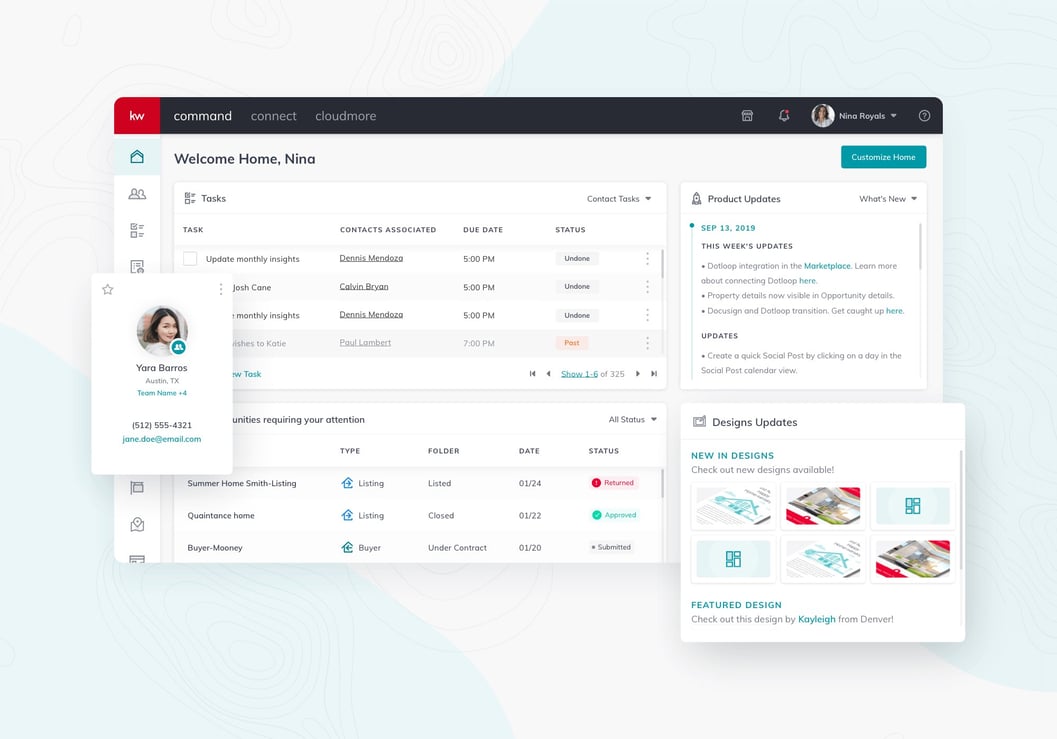-2.jpg?width=384&height=202&name=Bespoke_Hero_Background%20(1)-2.jpg)
Node.js development services company
Create high-performance web apps

Hire Node.js developers
Unlock the boundless potential of Node.js with the team of experienced software engineers. Our dedicated developers are masters in custom Node.js development, creating digital solutions that are tailored to your specific needs.
When you partner with us, you're not just choosing a development team; you're choosing a path to success. We prioritize speed, scalability, and strict adherence to industry standards to bring your unique business idea to life. Let's embark on this journey together and turn your vision into reality.
Get applications into production fast with rapid MVPs
Develop apps in record time
Node.js’s event-driven I/O model supports the handling of concurrent requests. As a result, your app is fast even when performing multiple operations at the same time.
Scale easily, enhance performance
The event-based model also enhances the scalability and performance of Node.js applications. Node.js usually scales better than most other common frameworks.
Become lightweight and efficient
The non-blocking and event-driven I/O makes web apps lightweight and efficient in the face of data-intensive real-time tasks running across distributed devices.
Free yourself from restrictions
Node.js gives you more freedom to build an app your way. Developers are not restrained by excessive rules and guidelines, so your app will be exactly as you want.

Revolutionizing private equity investment for individuals
Transforming the private equity landscape with Node.js and React.js
Technologies: Node.js, React.js, Amazon Web Services
Client Expectations:
- Enable individual investors to access top-tier private equity funds with low minimum investments.
- Build a secure, trustworthy platform that ensures compliance with strict security standards.
- Deliver an exceptional user experience.
Result of the Partnership: Moonfare successfully launched their platform, allowing individual investors to access premier private equity funds with ease and security, garnering media attention and the trust of industry leaders.
Case Studies of Netguru's Clients
-
-2.jpg?width=384&height=202&name=Bespoke_Hero_Background%20(1)-2.jpg) Spendesk provides spend management solutions. Netguru built Spendesk's internal banking system for handling incoming and outgoing payments. The client now has a fully-licensed service that meets the c...
Spendesk provides spend management solutions. Netguru built Spendesk's internal banking system for handling incoming and outgoing payments. The client now has a fully-licensed service that meets the c... -

Development and Design for a Top 10 Real Estate Company in the US
Keller Williams, the world’s largest real estate franchise, wanted to stay ahead of the competition by leveraging their data to boost artificial intelligence-powered technology. As a design and softwa... -

Sleek UX for a Luxury Fashion Ecommerce Platform
Ninety Percent wanted to create a fashion brand that would boost women's confidence with luxury collections as well as raise societal and environmental awareness. -
.webp?width=384&height=202&name=homemade%20(1).webp)
Development of Real Estate Platform for Proptech Startup
Home Made is a hybrid lettings agency that brings the quality of service of a top-notch traditional estate agency for a low flat fee. -

Backend and Frontend Support for a German Private Equity Investing Platform
Moonfare, a Berlin-based FinTech startup is building a technology platform that allows individual investors to invest in top-tier funds with low minimums (starting at €50,000). Netguru supported the c... -

Building a Fundraising Tool to Help The Vulnerable
The COVID-19 pandemic has affected the lives of many people, but since the beginning of the crisis elderly folk have been among the most vulnerable.
Build fast and asynchronous apps and dynamic websites
State-of-the-art technology
Node.js has gained substantial popularity. Companies such as Netflix, Walmart, Uber, and even NASA have leveraged Node.js as the backend for their web applications.
Unique framework features
An excellent fit for real-time applications such as chat, streaming services, or collaboration tools, it also excels in IoT apps and Single-Page Applications.
Robust server-side applications
Node.js can deliver a robust server-side web application utilizing a wide range of tools – combine JavaScript development and expertise in Node.js development to create apps like 'GitItBack'.
Freedom to create
Node.js developers can build you a dynamic web application and adapt to the latest tools and top technologies to improve scalable solutions.
Technology and services that deliver maximum value to your business
Python
A powerful technology used by multi-billion-dollar corporations and startups.
Ruby on Rails
Perfect for fast prototyping and the efficient development of full web-based projects.
Node.js
An excellent choice for building scalable and high-performance web and mobile apps.
Front-end solutions
Frameworks and battle-tested techniques that enable you to create a beautiful and user-friendly product.
Take advantage of proven processes and make your project a success
A good Node js development company will be able to take care of even the most complex of processes and will guide you smoothly towards your goal. At Netguru, our Node.js development processes are based on industry best practices and years of experience, so you can be sure that your company is in good hands.
How we work?
-
Select the right Node.js development company for your project
-
Brainstorm and analyze together with your web development consultants
-
Decide on the tech stack and overall approach with your development team
-
Create a beautiful, user-friendly web, desktop, or mobile app
-
Watch as your expert Node.js development team brings your app to life
-
Get your custom solution into the hands of your customers and grow your business
Find out what you can do with Node.js
Node.js is suitable for many different projects – here are some areas where it excels in performance:
Internet of Things
The most obvious advantage of Node.js as a backend for such networks is its ability to process multiple concurrent requests and events emitted by thousands or even millions of devices on the network. The avalanche of requests and data coming from IoT devices does not block Node.js servers thanks to their event-driven architecture and asynchronous processing suitable for I/O-heavy operations on the IoT network.
This makes Node.js fast as an application layer between these devices and databases used to store the data originating from them.
IoT developers working in data-intensive scenarios can leverage the low resource requirements of Node.js. Low memory requirements allow for the easy integration of Node.js as software into single-board controllers such as Arduino, widely used for building digital devices that form IoT systems.
Finally, the Node community has been an early adopter of the IoT technology, creating over 80 packages for Arduino controllers and multiple packages for the Pebble and Fitbit wearable devices widely used in IoT systems.
Real-time chat
Real-time chats can take the form of one-to-one or one-to-many group chats built on instant messaging (IM) or Internet Relay Chat (IRC) technologies.
Node.js provides all basic functionalities for building real-time chats of any complexity. In particular, Node has a powerful Event API that facilitates creating certain kinds of objects (“emitters”) that periodically emit named events “listened” for by event handlers. Thanks to this functionality, Node.js makes it easy to implement server-side events and push notifications widely used in instant messaging and other real-time applications.
Node’s event-based architecture also works well with the WebSockets protocol that facilitates a fast two-way exchange of messages between the client and the server via one open connection. By installing WebSockets libraries on the server and the client-side, you can implement real-time messaging that has lower overheads and latency and faster data transfer than most other, more conventional, solutions.
In Node, you have excellent support for WebSockets via such libraries as socket.io, ws, or websocket-node, thanks to which you can easily deploy efficient real-time chats and applications. With socket.io, for example, all you have to do to create a basic live chat is install the socket.io library on the server and the client and create event emitters and broadcasters that will push messages across the WebSockets open connection – this basic functionality can be achieved with just a few lines of code.
Complex single-page applications
Node.js is a great fit for SPAs thanks to its efficient handling of asynchronous calls and heavy I/O workloads characteristic of these applications. Node.js’s event loop allows to “delay” multiple concurrent requests from the client, which ensures smooth transitions between views and seamless data updates. Also, Node.js works well with data-driven SPAs, where the server acts as a backend that provides data to the client whereas the client does all the HTML rendering.
With such framework as Express available via the NPM repository, you can turn Node.js into a REST API streaming data and services from specific routes. Such approach helps reduce the server’s load while ensuring API sharing across different applications and environments. In this scenario, Node.js would only return the index page (index.html) while data would be sent via REST interfaces and controllers implemented server-side.
From the design point of view, such approach will ensure the clear separation of concerns (SoC) between models, controllers, and views with all data-related services implemented server-side.
Finally, Node.js is good for SPAs because it is written in the same language (JavaScript) as many popular JavaScript frameworks (Ember, Meteor, React, Angular) used in building SPAs. Since both Node.js and browsers use JavaScript, there is less context switching between them, and developers can use the same data and language structures and modular approaches both on the server and the client side. This results in faster development and better maintainability of your SPAs.
Real-time collaboration tools
As in the case of the real-time chat, Node’s asynchronous and event-based architecture is a great fit for collaboration apps. In these applications, many events and I/O requests occur concurrently. For example, several users can edit the same paragraph, comment, post messages, and attach media. Changes to one piece of content might be applied only after a cascade of events, where each step depends on the previous one.
Node’s WebSockets and Event API ensure that heavy I/O operations performed by many users do not make the server hang and that all server-side events and data are sent back to the client on time. By emitting push notifications to the client, Node.js also instantly updates the collaboration environment so that all users have a single and coherent representation of the application. This is precisely the reason why the team of project management app Trello uses the Node.js stack.
The engineering team of Trello decided that Node.js would be great to instantly propagate a lot of updates and hold a lot of open connections, thanks to its event-driven and non-blocking architecture. Among other real-time collaboration apps built on Node.js, we should also mention Yammer, a freemium social networking service facilitating private communication in enterprises.
Streaming apps
Node.js is excellent for the development of streaming applications thanks to its native Stream API. In particular, Node.js has an interface of readable and writable streams that can be processed and monitored very efficiently. Stream instances are basically Unix pipes that allow transmitting parts of the app’s executable code to the local machine while keeping a connection open for new components to download on demand.
Streams allow users to pipe requests to each other and stream data directly to its final destination. As a bonus, streams do not require caching and temporary data – just an open connection to stream app data from one place to another.
Microservices architecture
Node.js is an excellent solution for developing microservices and creating easy-to-use APIs to connect them. In particular, the Node.js repository features Express and Koa frameworks, which make it easy to mount several server instances for each microservice and design routing addresses for them. Node.js with Express allows for creating highly flexible modules responsible for specific parts of your app.
In addition, Node.js can be easily integrated with Docker and will thus allow you to encapsulate microservices in hermetic containers to avoid any conflicts between the application development environments used in each of them.
Using Node.js for microservices also benefits from Node’s lightweight requirements. Node.js with microservices significantly reduces app deployment time and enhances efficiency, maintainability, and scalability of your applications.
Microservices architecture also helps manage the division of labor in your engineering teams efficiently, enabling them to work on specific tasks without affecting other parts of your application.
Why hire Netguru for Node.js Development Services?
By partnering with a Node.js development company like ours, you can build fast and scalable web applications that are high-performing and efficient. Our exceptional Node.js developers help you create lightweight and bespoke software and web applications in record time, delivering maximum value to your business.
Node.js offers a way to get apps into production quickly, and it’s also a top choice for website development, building real-time chats, and creating real-time collaboration tools. By partnering with Netguru, your Node.js projects will come to life quickly and easily, helping you outpace your competition while propelling you on your digital acceleration journey.

Empowering Spendesk with SEPA Payments
Revolutionizing Spendesk's Payment Ecosystem with Node.js and Beyond
Technologies: Node.js, Koa framework with Typescript, Postgres DB, Kafka, Knex query builder, Docker, ArgoCD, Kubernetes
Client Expectations:
- Develop an internal banking system for handling SEPA incoming and outgoing payments.
- Achieve full SEPA compliance and certification from BPCE PS.
- Reduce reliance on external providers and enhance operational efficiency.
Result of the Partnership: Netguru's collaboration with Spendesk resulted in a fully-certified internal banking system for SEPA payments, reducing external dependency and increasing operational efficiency.

AI and cutting-edge technology for real estate industry
Transformative Partnership with Keller Williams: Node.js and AI-Powered Real Estate
Technologies: React, React Native, Node.js, Python, Django, Golang, PHP
Client Expectations:
- Leverage data to boost AI-powered technology in the real estate industry.
- Support the digital transformation efforts of Keller Williams.
- Enhance consistency, efficiency, and speed to market across multiple products.
Result of the Partnership: Netguru's collaboration with Keller Williams facilitated the successful integration of AI and cutting-edge technology into the real estate industry, enhancing efficiency and speed while maintaining consistency.
Our partners on working with Netguru
- "My experience working with Netguru has been excellent. Outstanding software teams are resilient, and our developers at Netguru have certainly proven to be that. Our Netguru friends have become as close to team members as possible, and I am grateful for the care and excellence they have provided."
- "We've worked with Netguru for several years now – perhaps longer than any other company. Our partnership is built on trust and mutual respect. Their engineering and design teams have enabled us to focus on building a great product for thousands of accommodation owners."
- "Working with the Netguru Team was an amazing experience. They have been very responsive and flexible. We definitely increased the pace of development. We’re now releasing many more features than we used to before we started the co-operation with Netguru."
Netguru in numbers
15+
Years on the Market
400+
People on Board
2500+
Projects Delivered
73
Our Current NPS Score
How can Node.js development help my business?
How much does it cost to hire Node.js developer?
The cost of hiring a Node.js developer can vary significantly based on factors such as their experience, location, and the specific requirements of your project.
Experienced Node.js developers may command higher rates than those with less experience. Additionally, the cost can be influenced by the location of the developer, as salaries and hourly rates vary from one region to another.
Custom project needs and the complexity of the work can also impact the overall cost. To get an accurate estimate, it's advisable to reach out to potential candidates or development firms and discuss your project's specific requirements and budget.
Are Node.js developers in demand?
Yes, Node.js developers are in high demand. Node.js is a popular runtime environment for building server-side applications, and it is widely used for web development and other server-related tasks.
Many companies and organizations rely on Node.js for its performance and scalability, which has led to a strong demand for developers who are skilled in this technology.
Node.js is considered a valuable skill in the tech industry, and the demand for Node.js developers is expected to continue to grow.
Is Node.js good for web development?
Yes, Node.js is commonly used and considered good for web development, particularly for certain types of web applications. Node.js is known for its non-blocking, event-driven architecture, which makes it well-suited for building real-time, data-intensive, and scalable web applications.
It is especially popular for developing server-side applications and APIs. Some of the advantages of using Node.js for web development include:
-
Fast Performance: Node.js is built on the V8 JavaScript engine, which is known for its speed and efficiency. This can lead to faster web application performance.
-
Scalability: Node.js is designed to handle a large number of concurrent connections, making it a good choice for applications that need to scale easily.
-
Rich Ecosystem: Node.js has a rich ecosystem of packages and modules available through npm (Node Package Manager), which simplifies development and allows for the reuse of code.
-
JavaScript Everywhere: Node.js uses JavaScript on both the client and server sides, which can lead to more consistent and efficient development.
-
Community Support: Node.js has a large and active community, so developers can find a wealth of resources and support.
However, it's essential to note that Node.js may not be the best choice for all types of web applications. It is particularly well-suited for applications that require real-time features, like chat applications, online gaming, and streaming services.
The choice of the right technology for web development depends on your project's specific requirements and your team's expertise.
Curious whether Netguru is the right fit for your project?
Schedule a free expert session with a Node.js Expert
Get growth tips, that will make your business sky-rocket.
They trusted us
Click for the details
Sorry, our forms might not work